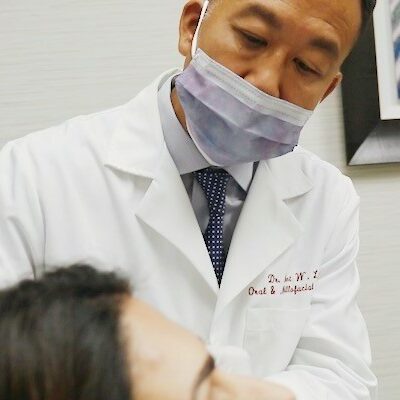Facial Trauma
Voted "Best in San Diego," La Jolla Oral and Facial Surgery is the go-to choice for Facial Trauma .
Our services are designed to change the way our patients live.

Ready to Make an Appointment?
Contact Us Today!
Call Us
Drs. Gramins and Lin are trained, skilled and uniquely qualified to manage and treat facial trauma. Injuries to the face, by their very nature, impart a high degree of emotional, as well as physical trauma to patients. The science and art of treating these injuries require special training involving “hands on” experience and an understanding of how the treatment provided will influence the patient’s long term function and appearance.
Our doctors meet and exceed these modern standards. They are qualified to treat the following conditions:
- Facial lacerations
- Intra oral lacerations
- Knocked out teeth
- Fractured facial bones (cheek, nose or eye socket)
- Fractured jaws (upper and lower jaw)

Our doctors are the Oral and Facial Surgeons to the San Diego Gulls Hockey Team and as such treat a wide range of facial trauma.
Dr. Gramins on his role with the San Diego Gulls Hockey team.
Ask the Doctor - Treating Facial Trauma
Types of Trauma
Facial trauma can occur at any time and without warning. Motor vehicle accidents, accidental falls, sports injuries, interpersonal violence, and work-related injuries can all result in facial trauma.
Results of trauma can range from injuries of teeth to extremely severe injuries of the skin and bones of the face. Typically, facial injuries are classified as either soft tissue (skin and gums), bone (fractures), or injuries to special regions (such as the eyes, facial nerves or the salivary glands).
Soft Tissue Injuries
When soft tissue injuries such as lacerations occur on the face, they are repaired by suturing. In addition to the obvious concern of providing a repair that produces the best cosmetic result possible, care is taken to inspect for and treat injuries to structures such as facial nerves, salivary glands, and salivary ducts (or outflow channels).
Drs. Lin & Gramins are well-trained Oral and Maxillofacial surgeons and are proficient in diagnosing and treating all types of facial lacerations.
Bone Injuries
Fractures of the bones of the face are treated in a manner similar to the fractures in other parts of the body. The type of treatment is dependent on multiple factors including: the location of the fracture, the severity of the fracture and the age, and general health of the patient. When an arm or a leg is fractured, a cast is often applied to stabilize the bone to allow for proper healing. Since a cast cannot be placed on the face, other solutions exist to stabilize facial fractures.
Injuries To The Teeth & Surrounding Dental Structures
Isolated injuries to teeth are quite common and may require the expertise of various dental specialists. Oral and Maxillofacial Surgeons are usually involved in treating fractures in the supporting bone or in replanting teeth that have been displaced or knocked out. These types of injuries are treated by splinting (stabilizing by wiring or bonding teeth together).
If a tooth is knocked out, it should be placed in salt water or milk. The sooner the tooth is re-inserted into the dental socket, the better chance it will survive. Therefore, the patient should see a dentist or oral surgeon as soon as possible. Never attempt to wipe the tooth off, since remnants of the ligament that hold the tooth in the jaw are attached and are vital to the success of replanting the tooth. Other dental specialists may be called upon such as endodontists, who may be asked to perform root canal therapy, and/or restorative dentists who may need to repair or rebuild fractured teeth. In the event that injured teeth cannot be saved or repaired, dental implants are often utilized as replacements for missing teeth.
The proper treatment of facial injuries requires a specialist who is well versed in emergency care, acute treatment, long-term reconstruction, and functional and aesthetic rehabilitation of the patient.


